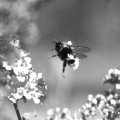A University of Queensland study has confirmed the importance of Pumicestone Passage in south-east Queensland as a spawning and nursery ground for fish species.
Pumicestone Passage - the area between Bribie Island and the mainland, from Caloundra to Deception Bay - was declared a marine park in December, 1986, preventing commercial fishing. Now only recreational fishing is permitted.
The area is a spawning ground for a large number of fish species including whiting, bream, flathead, tailor and sweetlip.
Zoology Department PhD student Tri Pham studied how several larval fish species - sand whiting, pilchards and anchovies - used Pumicestone Passage. The work included larval fish growth rates, the direction in which fish larvae migrated, and life cycle phases.
The study provided baseline information for fisheries study in south-east Queensland and information for fishery management policy of the region. Tri Pham said the study technique could be extended to other species in the area.
"People who will most benefit are the locals, who can boost tourism with increased knowledge of fish species," he said.
"It's harder to attract tourists back to fish in a region if they don't catch anything."
He found both whiting and pilchard spawned just outside Caloundra, then the small larvae moved into Pumicestone Passage for their development.
While whiting larvae did not travel further than 5km into the estuary, pilchards travelled south to Moreton Bay, growing in the process from 1-4mm in length to about 26mm at about six months. They were widely found in the western side of Moreton Bay, and near Raby Bay. As adults, they returned to their feeding ground in the coastal water north of Caloundra.
Tri Pham's studies also showed that anchovy spawned both outside and inside Pumicestone Passage. The majority spawned in the middle of Pumicestone Passage, and moved northward while growing, to reach the Caloundra entrance when they were about 24-26mm in length.
He said the three species had considerable economic potential. While Queensland had no pilchard factory, pilchards were a multi-million dollar business in South Australia, Victoria, Western Australia and overseas.
"Anchovy are a huge economic enterprise everywhere in the world," he said.
"Western Australia has concentrated on these smaller species, but the Queensland fishing industry specialises in larger table fish."
Tri Pham's work is part of a major study of macrozooplankton of Pumicestone Passage undertaken by School of Marine Science director and thesis supervisor Associate Professor Jack Greenwood since 1990. The last major study on fish larvae in the Moreton Bay region was conducted in 1902.
He said fish larvae, which were part of the zooplankton community, played an important role in the food web of the ecosystem.
An important spinoff of the project has been the development of a novel plankton catching technique. To collect the tiny fish larvae for the study, he devised a removable pushnet design which has attracted the interest of overseas researchers.
Tri Pham said the traditional research method for collecting fish larvae was to use simple surface nets towed behind boats. The disadvantage of this method was that larval populations dispersed to avoid craft, reducing the catch.
His novel design collects samples from the surface water column, and allows netting simultaneously as the boat progresses, away from the wash of the boat.
It is featured in a recent Proceedings of the Royal Society of Queensland and has been discussed in a forthcoming book on the marine environment by Dr Michael Kingsford of the University of Sydney. His work with pilchards and anchovy was also discussed at the International Larval Biology meeting in Melbourne in January.
His work will also be highlighted at the International Estuaries Research conference in South Africa this month.
He also has a sledge net design specifically for collecting samples from the bottom of the Pumicestone Passage.
Born in Vietnam, Tri Pham graduated bachelor of science from NiHon University in Tokyo, with his thesis on the marine life and fisheries of New Zealand. His master of science thesis at Victoria University in New Zealand examined the zooplankton of Hong Kong harbour. He joined the University of Queensland in 1993.
His said he was grateful for support by fishers in the region and by Caloundra residents.
For further information, contact Tri Pham, telephone 07 3365 4821, email: TPham@zoology.uq.edu.au.



